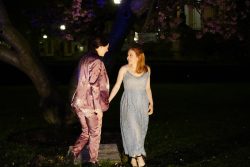Senior Staffer Levi Cohen braved the rain last night to go to the opening night of the King’s Crown Shakespeare Troupe’s spring show, Romeo & Juliet, directed by Asya Sagnak (BC ’19) and executive produced by Tina Simpson (BC ’19). There are two more performances, the first tonight at midnight, the last tomorrow at 8:00 pm. Attendance is free— just show up on Low Steps at the right time.
There’s no point in beating around the bush: Romeo & Juliet is probably the most fun an audience member can have at a Columbia theatre production this year. An outdoor, site-specific show that sets each scene of the Shakespearean tragedy at various locations across campus (examples: Low Plaza, the steps of Earl Hall, the plaza in front of Fayerweather), it runs the gamut from comedy to heartfelt romance to full-throttle tragedy.
PrezBo seemed to make a definitive anti-Shakespeare statement by turning off his weather machine for the opening scene last night, drenching both the audience and the cast in torrential rain. The energy of the troupe didn’t flag, however; instead, everyone seemed to bring their game even harder. This production represents a huge, coordinated effort by KCST: ensemble and crew members worked to run cables for lights, guide the audience (often with show-specific ad libbing), and pull off costume changes all over campus. And that’s not including all the behind-the-scenes work that must have been done with Columbia Public Safety to allow such a massive project to work. I almost feel bad describing specific scenes, because each artistic choice made was so delightful that I want it to be a surprise for every audience member.
(Part of the fun, honestly, was seeing the confused faces of passersby. The ridiculous romantic excess of the balcony scene was only heightened, for example, by people trying to leave a building; and the scene of Juliet’s first “death,” with accompanying mourning wails by her family members, stopped a few people in their tracks.)
Bailey Coleman (BC ’20) and Erin Hilgartner (CC ’21) were our Romeo and Juliet, and they delivered through the entirety of the show. From the early-act comedy and budding romance to the sudden build of tragedy, their performances were the heart and soul of the show. I really appreciate how thoroughly Coleman and Hilgartner stuck to what Sagnak said in her Director’s Note: “Romeo and Juliet are absolutely, uncynically in love.” It’s too easy to criticize them for being moonstruck teenagers, to write it all off and say that Shakespeare was laughing at his own creations. Much more interesting, and enjoyable, is to believe them and believe in them. It makes the tears at the end all the more painful.
- Coleman and Hilgartner r breaking my gay heart
Oona MacKinnon-Hoban (BC’21) and Tom Phelan (CC ’20), as Benvolio and Mercutio respectively, were a riot in the early scenes of the play. They had a delightfully chaotic energy that comes to a crashing and painful halt upon Mercutio’s death. (Phelan also milked that death scene.) Rose Meriam (BC ’19) was a standout as the Nurse, portrayed here almost like my favorite campy Jewish aunt called down from her Catskills summer retreat to babysit. Just like everyone else, Meriam’s fabulous comedy early on only strengthened the gut punch of her sobbing over Juliet’s body.
Nell Bailey (BC ’19) as Tybalt was a great and menacing presence; when she spoke, the atmosphere seemed to visibly change. Lily Whiteman (BC ’19) played Paris as an earnest, charming fellow caught up in a bad situation, and gave depth to a role that can easily be played as a mere plot device. Jack Becker (CC ’21) was a strong supporting player as Friar Laurence, the straight man to Romeo and Juliet’s dramatics and hysterics.
Joel Meyers (CC ’21) and Sophia Seidenberg (BC ’19) were Lord and Lady Capulet, with Will Cagle (CC ’20) and Maya Weed (CC ’22) their Montague counterparts. The Capulet parents are the beefier roles, and Meyers and Seidenberg did great work with their cruel treatment of Juliet turning to sorrow and devastation. I hated them for their inability to understand, and felt for them as they wept by Juliet’s corpse (Seidenberg in particular being a great crier).
The ensemble, directed by Aydan Shahd (BC ’20), was a strong presence throughout, from the opening, delightful fight scene to the Capulet party to the end-of-play mourning. There was also music! Composed by Ramsay Eyre (CC ’21) and played by Eyre, Claire Walter (BC ‘19), Mark Pierce (CC ’20), Julia Cassinelli (BC ’20), and Juliana Kaplan (BC ’19), it filled out the open-air spaces quite nicely. We even got treated to some scene transition serenades.
An infinite amount of praise out to be showered on the crew for their work all show long, and the design team for what they pulled off. Sagnak’s direction kept things moving and never let the pacing sag, alongside the aforementioned great use of Columbia’s space. Perry Levitch (BC ’19), the Artistic Director, created some beautiful costumes, as you can see in the photo of Romeo and Juliet above. (I want that floral suit!) The Capulet-Montague color coordination was done well without being overdramatic, and everything worn by Mercutio and Benvolio was delightful. Ally Benitez (BC ’21) managed to create effective lighting in a traveler outdoor show, no small feat. Her use of strong purples during the romance scenes was a particularly great touch. And I can only imagine what Persis Rao (BC ’20), the stage manager, and Benitez, the Technical Director, had to do to keep the show running smoothly.
My one ‘caveat emptor’ for the prospective audience member is that it can occasionally be a bit difficult to get a good position to watch the scene: there aren’t raked seats, after all, so you’re standing in a crowd around a single point of focus. The show is choreographed around giving people at the back of the audience a chance to be at the front, with several scenes occurring directly opposite the previous (meaning the audience just needs to turn around), but it can still be a bit tricky. If you’re comfortable squatting up front, that’s a good option. Make sure to be kind and generous to your fellow attendees: in this, more than most other shows, the audience should work together to make their experience a collectively good one.
In conclusion, I can’t urge you enough to go and see this show. I don’t think I ever want to just sit in a theatre to watch a show again.
- Alma wearing both Capulet and Montague colors. She doesn’t pick sides y’all
Poster via KCST Facebook Page
Photos by Anna McClelland-Enger
Photo of Alma via Levi Cohen


 2 Comments
2 Comments


2 Comments
@Anonymous I LOVE YOU METCUTION
@Anonymous LEONARDO DICAPIGN COULD NWVER